|
|
History of Barcelona and Catalonia
The spanisch city Barcelona looks back to a more than 2000 year old history. By talking about the history of Barcelona, at the same time, the history of Catalonia and in a certain way the history of Spain is also mentioned. It is as impossible to write down the pure city history of Barcelona as the pure city history of Berlin is. As Berlin is also a piece of german history, Barcelona reflects an important piece of Spanish and Catalan history. The following historical summary of the city Barcelona and the country Catalonia is long and painful to read. But those who are informed about the history of the city and the country before visiting Barcelona, will understand many things much better during the sightseeing tours than without an historical background The Pre-historyThe current status of the archeology proves that already 130.000 years ago, some neanderthals lived in the Catalonia of today. Therewith, the Catalan region counts to the oldest settlement areas of the human being. Thounsands of years before Christ, the area was already inhabitated. Up to approximately 4.000 years before Christus, the former inhabitants of the country lived as hunters and collectionists. It was then when the humanity started animal husbandry and the ariculture. At the beginning of the historical tradition, thus in the first millenium before common era (the time before that is called prehistory ), Catalonia already was sparely inhabitaded by the Iberian aboriginals. The settlement area was mainly in the proximity of the small river Ter (at the north of Barcelona). The AntiquityIn the first millennium before Christ, there were increasing amounts of Greek trade ships landing at the Mediterranean coast of France and Spain, so that the first contacts between the local people and advanced civilisations took place. For these former sailors, the Iberian peninsula was, of course, the end of the world. In the year 600 before Christ, the Greeks established the oldest city at the French coast, Marseille, as a trade settlement. Also by this time, they established the first city at the Spanish coast, located a little northern to Barcelona, Empurion (Empúries). The remainings of that time can be still seen in Empúries. 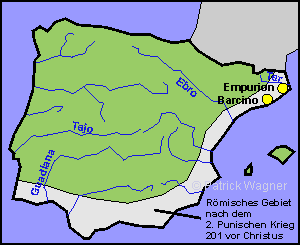
From that time, the Greeks and later the Romans had a decisive influence on the culture of the local population and in the course of the centuries, an Iberian culture came up and developed that was supposed to be one of the most important antique cultures in Europe; Where does actually the name Iberian come from? The Greeks and the Romans named Iberian all inhabitants that lived close to the river Iberus. Later, the term was expanded to the whole peninsula. While the Greek colonists came from the east, from the south west, the north African Carthaginians pushed to the Spanish Mediterranean coast. In the second Punic war, the Romans won against the Carthaginians who then retired to the west of Europe. The Romans settled down at the south Spanish coast and divided in the year 197 before Christ the whole Iberian peninsula in two big provinces. From then, the big romanization of the Iberian population began. Slowly, the local people adapted to the habits, the language and the culture of the settlers. In the course of the following century, both Iberian provinces were further divided. The city Barcelona was established a few years before the turning point in history. What we today call the oldtown is the 2000 year old Barcino. There was a wall surrounding the oldtown with numerous watchtowers. Two aqueducts provided fresh water from the mountains to the city. Some parts of the wall and the museum can be still seen today at the Museu d'Història de la Ciutat. During the time of the emigration of nations and the decay of the Imperium Romanum, the Visigoth intrused Catalonia and made Barcelona to their capital. But there were no drastic changes in Catalonia until the moors settled down on the Iberain peninsula. The Moors in the Iberian Peninsula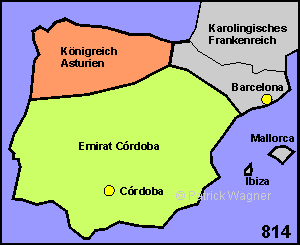
At the beginning of the 8th century, the Iberian peninsula started a complete new chapter of its history that was when in the year 711, some Arabian Berbers from the north of Africa landed at the south tip of Spain. The moors - this is the way the settlers were called in Europe - slowly expanded throughout the Iberian peninsula and made Córdoba to their capital. A powerful antipole was formed at the 9th vy the Frankish Empire under Charlemagne. In the year 801, the city Barcelona and some Iberian areas beyond the Pyrenees came under the big Frankish Empire. At the beginning of the 10th century, the moorish also conquered the Balearic Islands; meanwhile, the emirate Córdoba firmly established in the southwest of Europe and could opposite effectively the northern kingdom that partly wereat odds with each other. 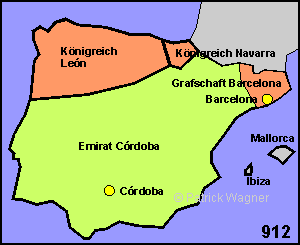
As bad as it sounds when hearing that the country was invaded by islamics, as good was the influence of the moorish people to the country and the inhabitants. In the centre, Córdoba, numerous artists and academics from Far East settled down. The moorish tought the local people how to practice an effective agriculture. By this way, from the Emirate Córdoba, an economic centre of Europe was made; the advances of this area were significantly. The moors expanded widely on the Iberian peninsula, but they never conquered one area: Barcelona and the territory around the city. While at the beginning of the 9th century, Barcelona was still under the Frankish governance, in the year 874, the independent county Barcelona was formed, that from then stood between the moorish and the frankish fronts. At the beginning of the second century, either the Emirate Córdoba as also the remaining areas of Spain dismembered. But the county of Barcelona united with Aragón and both became together a powerful kingdom with the potential to push into the south to the islamic areas; At the same time, the Castilians came from the north and the Portuguese from the west to the moorish area. The recapture of the country was called the Reconquista. As the individual kingdoms started the recapture independently from each other, it took a long time until the country was again under the sign of Christianity. 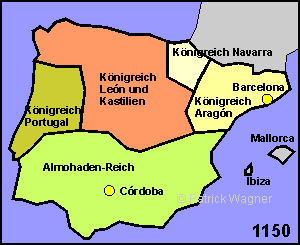
But it still took some centuries until the Almohad dynasty was definitely displaced from the European mainland. In the 12th century, the name Catalonia appears for the first time as also an own country language. During the turbulences of the emigration of nations and the moorish governance, many people retired to the Pyrenees. When the land of the mountains started to run short, these people inhabitated the are that today is Catalonia; Now it also gets clear why the Catalan language has so much in common with the French language. The big kingdom Aragón extended continuously. First, the French areas were conquered but later on they were lost again. Jaume I (The Conqueror) focused his politics of expansion in the Mediterranen area. Thus, the islands Mallorca and Ibiza were conquered. The Unification of Catalonia with CastiliaUp to the end of the 15th century, Catalonia developed to a real Mediterranean power. For some long time, there were rivalities between Catalonia and Castilia. With the marriage of Isabella from Castilia and Ferdinand from Aragón, both crowns were united and a regession began in Catalonia that should last for several centuries. In the year 1516, the united Catalonia and Castilia were connected to the big Kingdom of Habsburg under Karl I. A time of numerous turbulences and rebellions followed. Of course, the war of 30 years between France and Spain took place on Catalonian territory. There were further turbulences in the Ctalonian cities. The Catalans indeed enjoyed a certain independance during long period of time, but Philipp V suspended in the biginning of the 18th century all special rights of the Catalans including their own language. Of course, the inhabitants rebelled vehemently against this repression. From the castle of today, the rebelling population was kept in check. Since long ago, Barcelona and Catalonia was not an independent kingdom anymore; it became a part of Castilia and even repressed by the Spanish central government and strongly limited in its cultural and linguistical freedom. Thus, there were two ethnic groups in a united country, the governants and the repressed. It is self evident that under such circumstances, in the course of the years there were numerous rebellions and turbulences in the country. Boom and Independence Tendencies in the 19th CenturyWhile the first half of the 19th century (after the French revolution) was marked by internal turbulences in the country, at the same time and specially in the second half of the century, an unbelievable economic boom came up in Barcelona and in the whole of Catalonia. While the economy of the remaining Spain was mainly marked by the agriculture, in Catalonia, an efective textile industry developed. At the end of the 19th century, the contrasts between the highly industrialized Catalonia and the rural Castilia were so strong that the Catalans developed a new self-esteem and patriotism. The culture and the language of the Catalan population that were repressed for a long time should now revive; this movement should be the period of the Renaissance. The Catalan language experienced a new flourish. The most known and significant movement in the course of the Renaissance is the development of a new art form, the Modernisme, that decisively marked the cityscape. The most famous artist and arquitect of the Modernisme, Antoni Gaudí, put some emblems into the city that made very clear that here, nothing is copied from others but that something own, independent and new is created. Thus, in the Modernisme, one discovers a piece of independence from the rest of Spain and from the rest of the world. The world exhibition in the year 1888 in Barcelona prompted the urban planners to carry out numerous building projects in the style of the Modernisme. During the industrialization in the second half of the 19th century, Barcelona bursted at the seams. Long ago, the old city walls lost their significance; the city had to be enlarged. By having today a walk through the Eixamples, one notices what the arquitects and urban planners of that time built up: a new, huge city district in checker-board pattern with generous and wide streets and uniformly build house blocks with patios. A new gas, electricity and water provision was arranged, the streets were illuminated at nights and for the population, some hospitals and police stations were arranged and as a transport mean, a tram pulled by horses was established. Catalonia and Barcelona in the 20th CenturyIn the history of Barcelona and Catalonia, no other century had more ups and downs than the previous one. At the beginning of the 20th century, the cultural and linguistical independence movements were continued at a political level. In the yeat 1907, an Institute for Catalan Studies is established as a sign of the increasing significance of the Catalan language. 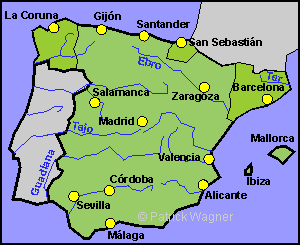
In the year 1914, the time finally came: by establishing the Mancomunitat de Catalunya, for the first time in more than 200 years, a politic organ was created that regulated some parts of the life in Catalonia independently from the central government. But this political self admininstration was only supposed to take place until the year 1925, as although Spain remained neutral during the first world war, in the year 1923, the Spanish parliament was replaced by a military dictatorship over the whole country. Catolonia got its autonomy already back in the year 1932 in order to be completely occupied again in the year 1939 by the troups of the new military general Franco. Until his death in the year 1975, Franco remaind the Spanish dictator and repressed the whole population. After the death of Franco, Spain becomes a constitutional monarchy with the King Juan Carlos I. Either the Catalan as also the Basque and Galician languages are recognized as official languages of the respective regions. Catalonia got an independent governance that could decide on its own about big parts of the country politics. A further hihlight of the city history experienced Barcelona in the year 1992, when the 25th Olympic Games took place in the Catalan metropolis. Huge amounts of money were spent to renew the city: the olympic sports facilities on the Montjuic are nearly modest compared to the rest of the constructional changes made in the city: trains were subterraneously arranged, the olympic harbour was completely new built, beaches and promenades were newly designed and numerous streets newly constructed. Barcelona and Catalonia TodayToday, Catalonia governs in certain areas of the politics completely independently from the Spanish central government. The Catalan language dominates, either in the vernacular as also in schools and universities. Those who want to find a job in the public offices of Catalonia have to certify that they dominate the Catalan language. Within the Catalan population, the wounds of the long Spanish central repression are not cured yet at all. Specially the older people have no good word to say about the rest of Spain. And one should be careful to call such a person a Spaniard instead of a Catalan. Still today, the refusing attitude of the population to Madrid is still noticeable when in Barcelona something gets wrong: if any kind of mischance or catastrophy happens, if the budgeting is not all right or if Barcelona does not win the football championship - always the core of Spain is to be blamed... 
Copyright: Patrick Wagner, www.tourist-guide.biz |
||